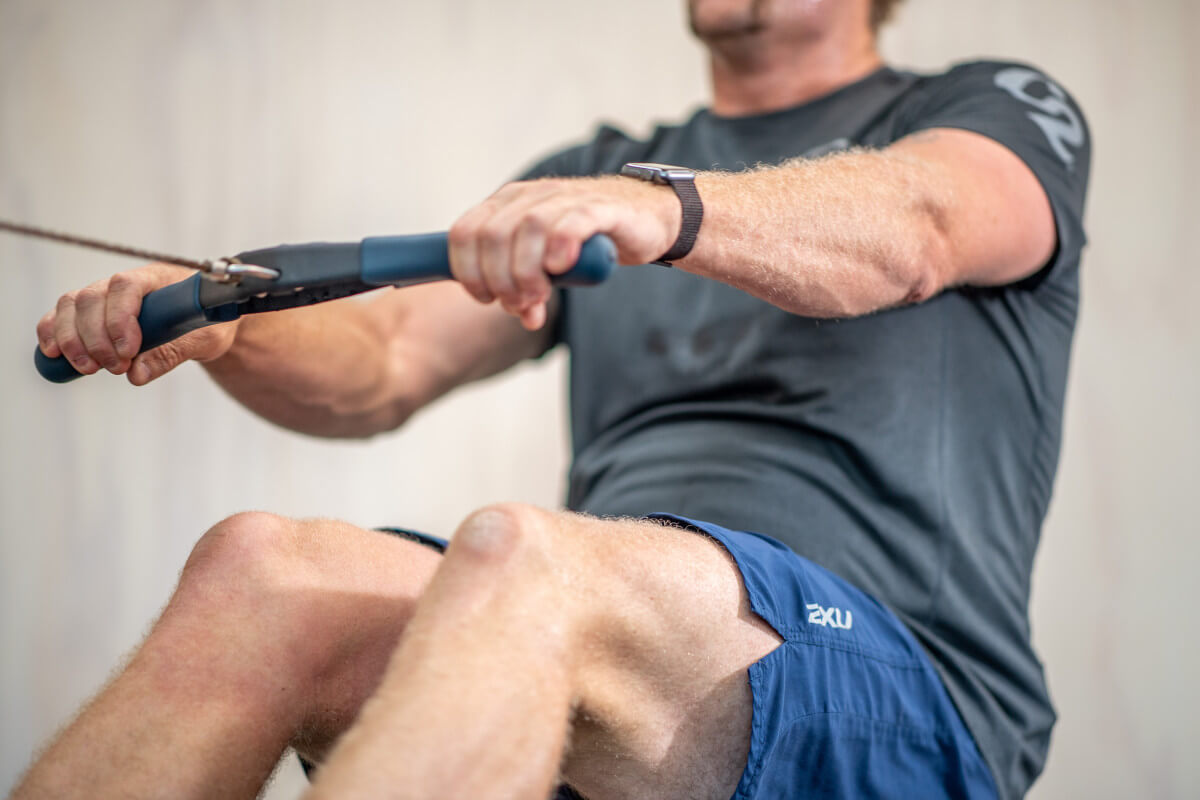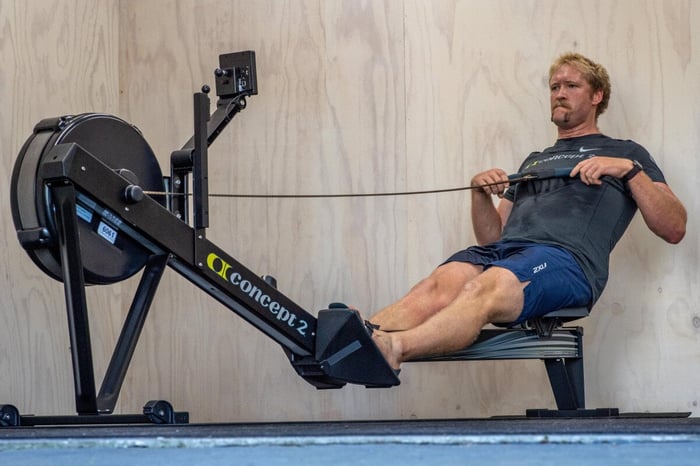In every rowing stroke, we are either working (driving) or resting (recovering). These phases are bookended by two positions called the Catch and the Finish. In this article, we’re diving into the details of the Finish to uncover expert tips from two-time Olympic Gold Medallist Eric Murray for improving your form and building speed! The companion article to this is asensei's Essential guide to the indoor Rowing Catch. The Finish is the final action of the drive phase where you have used your arms to draw the handle into your chest. In this position, your body is tall, shoulders are behind the hips and the handle is resting somewhere between your rib cage and your abdominal muscles, with flat wrists. After the Finish, your next movements involve extending the arms away from the body as you transition into the recovery phase. This article will explain in more depth how to both practice and perfect the Finish, why firmness and relaxation are fundamental principles for unlocking speed, as well as helpful hints from our specialist coaches and a technical drill for you to try at home, in the gym or at your club!
What does the ideal indoor rowing Finish look like?
The indoor rowing Finish can be explained and understood in a few different ways. In this section, we are going to focus the correct body positions, as well as the movements before, during and after the Finish. Before going any further, let's consider how it all works on the water. In a boat, a rower will complete the Finish at the end of the drive phase, about halfway through the body swing, before dropping the hands to let the blades pop out of the water. In order to achieve a clean extraction of the blade, the arms must pull the handle to the chest firmly. This allows the feet to stay connected with the footplate, which keeps you balanced and steady. Once the oars are in the air, the boat can feel unbalanced. By relaxing our bodies and avoiding tension in the shoulders, the boat will feel steadier during the recovery. Surprisingly, these sensations and points of focus are no different on your indoor rowing machine, one of the reasons why the erg is extensively used by on-water rowers and dedicated indoor rowers alike!
On your erg, you approach the Finish position during the drive phase. One of the aims of the Finish is to continue the acceleration from the legs pushing and hips opening; ensure you have the correct sequencing of legs first, body second and then your arms. As you push against the footplate, you are creating a connection with the whole body that must be maintained until the handle reaches the chest. During the Finish, you are aiming to hold on to this pressure by drawing the elbows past your body. Focusing on the elbows instead of your hands will help you avoid gripping the handle tightly. Once the handle reaches your chest, you should be sitting tall, legs pressed firmly against the footplate, with your shoulders behind your hips. It is important to stress that rowers do not spend any great amount of time at the Finish - it is part of the continuous flowing motion of a stroke. Think about extending your arms at the same speed as you bring them in.

Notice how Eric Murray holds the handle towards the end of the drive phase. The wrists to the elbows are flat, as the elbows pull back.
The timing of the Finish is also worth thinking about; specifically, the point at which the arms start to pull the handle. For most people, the beginning of the finish will vary as we all tend to row a little differently. Instead of thinking of a rigid point which separates the body swing and the arm draw, focus on using your whole body as effectively as possible. Using your arms at the beginning of the drive will tire you quickly and limit the power you can apply with the legs. However, using your arms too late will lead to a lost connection with the footplate causing you to feel unbalanced. We should think about drawing in the finish about halfway through the stroke with a focus on holding on to the tension in the chain. Ensure that you continue pulling on the handle right the way until it reaches your body, with the elbows and triceps keeping pressure on the fingers. Remember, most of the power of the stroke comes from the legs first, then the body. Handstands are hard for a reason!
Eric Murray on the Finish
Eric Murray, double Olympic champion and asensei coach, has some excellent tips on how to maximise the Finish. In the short clip below from one of his post-workout Livestream Q&As, he starts by explaining that the Finish should feel like ‘sitting on a couch with feet up on the stool and beer in hand’, which indicates that there is a lot of relaxation and natural positioning to consider. The body swing through from the drive phase of the stroke should lend itself to reaching a naturally upright position at the Finish, where your core muscles in the tummy and back are engaged to keep you tall. Eric uses the phrase ‘sitting back into the machine’, so think strong core, relaxed in the upper body and using the Finish as a mechanism to allow you to complete one stroke and begin another.
Clip: Eric Murray talks about the Finish position in one of the asensei Livestream Q&A sessions
Another tip Eric has for success at the Finish revolves around hand speed into and out of the position. This is important to think about as you recycle the power generated from one stroke into the next. The consensus in rowing is that hands should leave the body at the same speed they arrived at; there is no room for slowing down or really pausing in the Finish as it is the connector between two separate strokes. In the excerpt below Eric shows how continuous hand speed at the Finish contributes to a smoother, more efficient stroke.
Clip: Eric Murray talks about hand speed around the indoor rowing Finish position in an asensei Livestream Q&A
Feet-out Rowing
One of the best indoor rowing drills to test and improve your technique at the Finish is called ‘Feet-out Rowing’. To avoid feeling unbalanced or wobbly during this drill, think about gradually increasing the power for the first few strokes until you feel comfortable. To start the drill, first unstrap your feet from the footplate whilst sitting on an erg. Begin with arms only rowing – the aim is to push against the footplate whilst you pull in with your arms. If practiced correctly, your feet will stay connected with the plate instead of lifting off. From there, build up to body swing and then incorporate the leg drive. If you’re able to row full slide without your feet lifting off the footplate at the Finish, then you likely achieving a good connection at the Finish. Feel free to practice this drill during your warm-up to build your muscle memory during the workout.
For more information on Feet Out Rowing, head over to asensei's guide to Feet Out Rowing - benefits and pitfalls.
Summary
The Finish represents the last action of the drive phase which requires a focus on both firmness and relaxation as the same time. Done correctly, you will be able to maximise your overall power application while resetting your balance for the next stroke. After reading this article, try to implement what you've learned in a real workout. When practising the Finish, consider the body position – are you sitting upright, handle loosely gripped and resting between rib cage and stomach, and are your elbows tucked in behind your body? The Finish represents the transition from one stroke to the next, so think of it as a way to recycle your power and set you up for a strong connection in the next stroke.
DOWNLOAD ASENSEI TODAY
Rowing is better in the asensei app. If you want to improve your technique you will find drills and skills and real-time tips as you row. You will have all the key stats displayed on screen during your session, you will have asensei set you personalized goals, you won't need to program the machine or take note of your results, asensei does it all.
The app also features a curated selection of livestream workouts, with personalised goal setting and tracking in the (RE)LIVE program.
|
asensei is FREE to download and with no commitment you can trial the first 3 workouts in the (RE)COMMIT program and also workouts from MASTER THE BASICS, (RE)FOCUS, SWEAT FACTORY and BE A DARK HORSE. All you need is an iPhone and access to an asensei Compatible rowing machine from Concept 2, WaterRower or FluidRower with a bluetooth capable monitor. |




